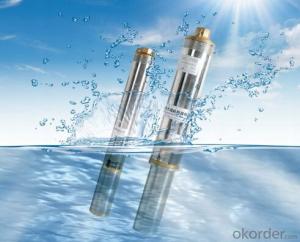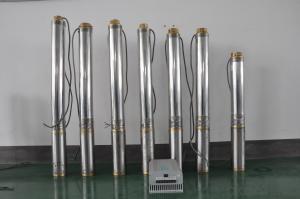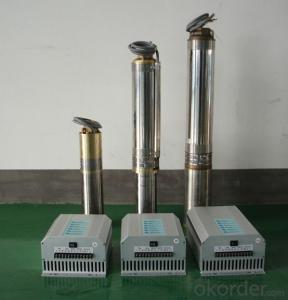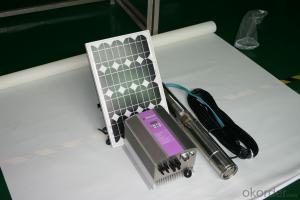Solar Water Pump Centrifugal Pump System 0.65KW for Agricultural Irrigation
- Loading Port:
- Shanghai
- Payment Terms:
- TT OR LC
- Min Order Qty:
- 10 pc
- Supply Capability:
- 1000 pc/month
OKorder Service Pledge
OKorder Financial Service
You Might Also Like
Solar Water Pump Centrifugal Pump System 0.65KW for Agricultural Irrigation
The photovoltaic pumping system is different from the traditional AC pumping system , and the photovoltaic pumping system utilizes solar cells convert solar energy into electric energy , then the photovoltaic pumping inverter drives ac motor for the pump running , and pumping up water from water well , river , lake etc areas and then transport to the destination to satisfy our requests for the water demand .
Photovoltaic arrays adopts solar radiation energy to convert it to electric power ,providing the motive power for the whole system . And the function of the solar pumping inverter is converting the DC power output from PV array to AC power to drive the pump to finalize the water pumping up as well as adjusting the output power real-timely according to the change of sunlight intensity , in this way , the system realizes the max power point tracking and the solar energy can be utilized furthest
The whole system solves the water pumping up requests perfectly , omitting the battery bank and charge controller etc equipments , so it is very economical and environmental . Since they are with the merits of low carbon , energy conversation , environmental protection etc , so they have a broad market foreground and great social value
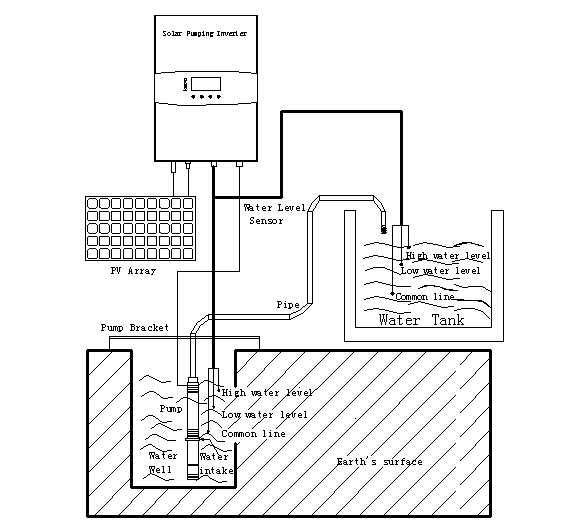
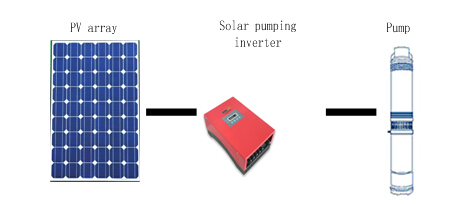
2.2 Application
Agricultural irrigation
Desert manage
Domestic water
Grassland animal husbandry
city waterscape
Island water supply
Landscape and fountain system of municipal engineering , city square , hotels and residence community
2.3 About product
This product is using a high performance digital signal processing chip, can provide solution for solar water pumpingsystem with high cost performance. Solar pumping system as a whole block diagram as shown in 2.
SHP series inverter has the following features:
a. True max power tracking technology (TMPPT) with our own intellectual property; effectively improve the use ratio of PV array. The stable tracking efficiency can reach 99.2% , Solving the problem of bad tracking efficiency and running unstability under the situation of sunlight intensity quick change when comparing with the traditional MPPT method .
b. Adopt efficient IPM power module from Mitsubishi Company with high reliability.
c. With the function of high and low water level detection , high safety factor.
d. Automatic anti-drying protection function , with multi-protection for motor
e. Multi-language LCD display , easy for operation , very user-friendly
f. The independent developed principal computer with our own intellectual properties , remote monitoring is available
g. Modular design , direct plug-in terminal , good-looking appearance, easy for installation , operation and maintenance .
h. Suitable for the pump adopted three phase asynchronous motor
i. Complete digital control , with the function of full automatic running and data storage .
j. Perfect protection system , with the protection function for lighting , over voltage , under voltage , short circuit , over loads , water drain off , low sunlight , over heating etc ,
k. Adopt the complete radiating system , so radiating efficiency is better and the service life is longer
l. Through strict environmental test , adapt the rigorous environment :-10℃~+50℃
m.No impacted mains supply power switch function (optional ), All-weather running available
n. Through strict environmental test , adapt the rigorous environment :-10℃~+50℃
FAQ
1. How fast will my system respond to a power outage?
Our solar inverters typically transfer to battery power in less than 16 milliseconds (less than 1/50th of a second).
2. What kind of batteries do the systems include?
Our solar backup electric systems use special high-quality electric storage batteries.
3. How do I install my system?
A solar backup inverter is connected to a home electric system , we will supply detailed installation manual and videos for our customers .
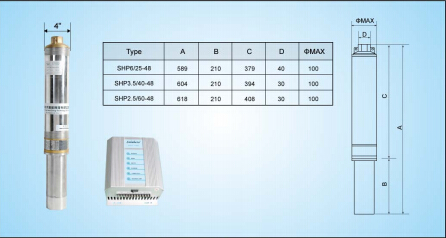
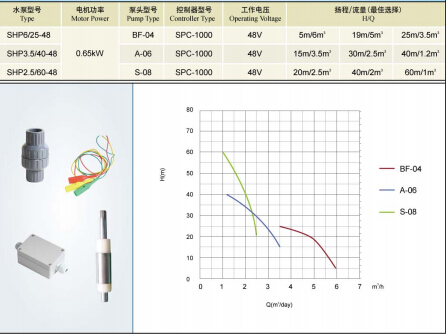
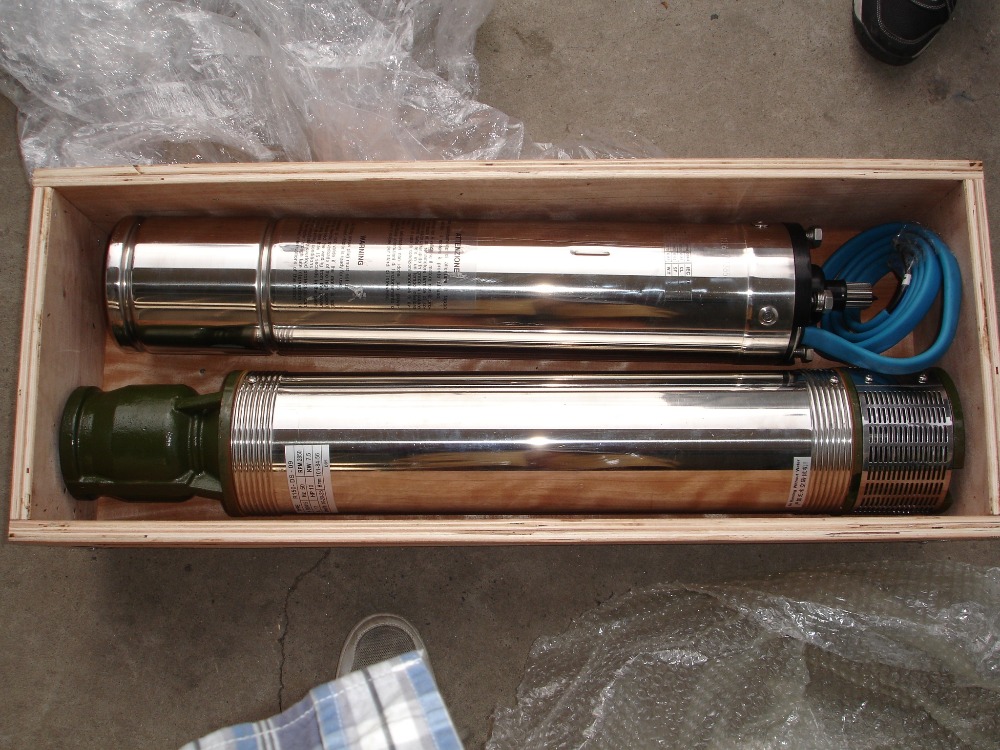
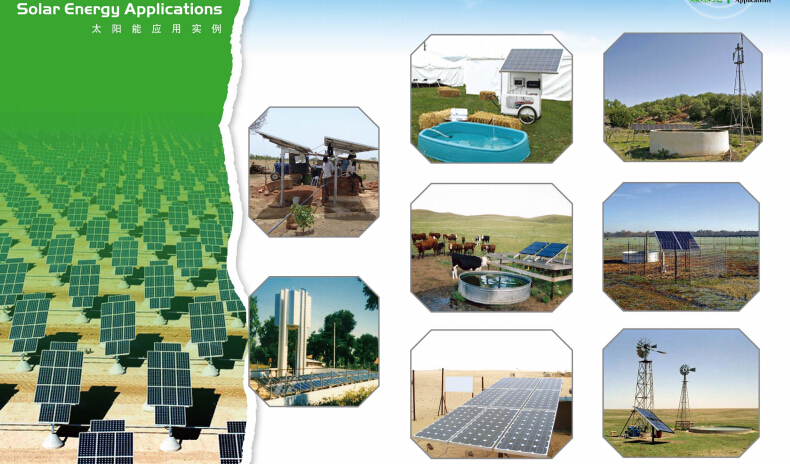




- Q:Can a solar pump be used for water supply in agricultural greenhouses?
- Yes, a solar pump can be used for water supply in agricultural greenhouses. Solar pumps are an eco-friendly and cost-effective solution for providing water to plants in greenhouses, as they use solar energy to power the pump. This eliminates the need for electricity or fuel, reducing operational costs and environmental impact. Additionally, solar pumps can be easily installed and are low-maintenance, making them a suitable choice for water supply in agricultural greenhouses.
- Q:Can a solar pump be used for wastewater recycling?
- Yes, a solar pump can be used for wastewater recycling. Solar-powered pumps are an eco-friendly and cost-effective solution for pumping and treating wastewater. They can efficiently move the water from one location to another, facilitating the recycling process. Additionally, solar pumps eliminate the need for electricity, reducing the operating costs and environmental impact associated with traditional pumps.
- Q:What is the pump for solar hot water
- If it is by way of manual pressurization, then it is more, all in line with the head of the flow of hot water pump can be.
- Q:How does a solar pump help in reducing the use of chemical fertilizers?
- A solar pump helps in reducing the use of chemical fertilizers by providing a sustainable source of water for irrigation. With a solar pump, farmers can efficiently water their crops using solar energy, reducing the reliance on fossil fuel-powered pumps. This enables farmers to better regulate the amount of water used, preventing over-irrigation which can lead to the leaching of nutrients and the need for additional chemical fertilizers. Additionally, solar pumps can be paired with drip irrigation systems, which deliver water directly to the plant's roots, minimizing water wastage and ensuring that fertilizers are efficiently utilized by the crops.
- Q:Can solar pumps be used for water supply in mining or construction sites?
- Yes, solar pumps can be used for water supply in mining or construction sites. They are a sustainable and cost-effective solution that can provide a reliable source of water for various purposes, such as dust control, equipment cooling, and drinking water supply. Solar pumps eliminate the need for electricity or fuel, making them suitable for remote locations and reducing operational costs. Additionally, they are environmentally friendly and can help reduce carbon emissions compared to traditional pumps powered by fossil fuels.
- Q:Can solar pumps be used for water supply in educational institutions or universities?
- Yes, solar pumps can certainly be used for water supply in educational institutions or universities. Solar pumps are a sustainable and renewable solution that can provide a reliable and cost-effective water supply. They can be utilized for various purposes such as irrigation, drinking water supply, and even wastewater management. With the increasing emphasis on sustainability and green initiatives, solar pumps offer an excellent option for educational institutions and universities to meet their water supply needs while reducing their carbon footprint.
- Q:Is it possible to store excess solar energy generated by the pump?
- Yes, it is possible to store excess solar energy generated by the pump. One common method of storing excess solar energy is through the use of batteries. These batteries can store the excess energy generated during the day and then release it during periods when the pump is not generating enough energy, such as at night or during cloudy days. Additionally, other energy storage technologies such as thermal energy storage or hydrogen fuel cells can also be used to store excess solar energy for later use by the pump. These storage solutions allow for a more efficient and reliable use of solar energy, ensuring that the pump can operate even when there is no direct sunlight available.
- Q:Can a solar pump be used for desalination processes?
- Yes, a solar pump can be used for desalination processes. A solar pump utilizes solar energy to power the pump, which can be used to extract water from sources such as wells, rivers, or oceans. In the case of desalination, the solar pump would be employed to draw seawater and transport it to the desalination plant. Desalination is the process of removing salt and other impurities from seawater to make it suitable for human consumption or irrigation purposes. Solar pumps are an ideal choice for desalination processes due to their use of renewable energy, making them cost-effective and environmentally friendly. Solar pumps can be utilized in various desalination techniques such as reverse osmosis (RO) or multi-stage flash (MSF) distillation. In the RO process, the solar pump is used to pressurize seawater through a semi-permeable membrane, separating the salt and other impurities from the water. In MSF distillation, the solar pump is employed to transport seawater to the heat exchangers where it is heated and evaporated, leaving behind the salt and other impurities. The use of solar pumps for desalination processes has several advantages. Firstly, solar energy is abundant and free, so it significantly reduces operational costs compared to traditional fuel-powered pumps. Solar pumps also require minimal maintenance and have a long lifespan, making them a reliable and sustainable option for desalination plants. Additionally, using solar pumps for desalination processes reduces reliance on fossil fuels, contributing to a reduction in greenhouse gas emissions and overall environmental impact. This aligns with the global efforts towards clean energy and sustainability. In conclusion, a solar pump can indeed be used for desalination processes, offering a cost-effective and environmentally friendly solution for extracting and treating seawater to make it suitable for various applications.
- Q:Can a solar pump be used for desalination or saltwater conversion?
- Desalination or saltwater conversion is indeed possible with the use of a solar pump. In fact, solar pumps are commonly employed alongside reverse osmosis (RO) systems to eliminate salt and other impurities from seawater or brackish water. The solar pump plays a crucial role in driving the RO process by supplying the necessary energy. This process involves pushing the saltwater through a semi-permeable membrane to separate the salts and produce fresh water. This method of desalination proves exceptionally beneficial in remote areas with limited access to electricity since the solar pump relies solely on solar energy, eliminating the requirement for a grid connection. Additionally, solar-powered desalination is an environmentally sustainable solution that reduces reliance on fossil fuels and minimizes greenhouse gas emissions.
- Q:How does the installation cost of a solar pump compare to a traditional electric pump?
- Compared to a traditional electric pump, the installation cost of a solar pump is generally higher. This is because solar pumps require additional components like solar panels, inverters, and batteries, which can increase the overall installation expense. Furthermore, the complexity of installing a solar pump may necessitate specialized knowledge and expertise, adding further to the installation costs. In contrast, traditional electric pumps usually have a simpler installation process as they only require connection to the main electrical grid. The infrastructure for electric pumps is already established in most urban and rural areas, making the installation process more straightforward and cost-effective. Despite the higher installation cost, solar pumps offer numerous long-term benefits that can outweigh the initial expenditure. Solar pumps operate using renewable energy, significantly reducing or eliminating electricity bills, thus making them cost-effective in the long run. Additionally, solar pumps are eco-friendly and contribute to sustainable development by reducing carbon emissions and decreasing dependence on fossil fuels. Therefore, although the initial installation cost of a solar pump may be higher, the potential savings from reduced electricity bills and the environmental advantages make it a worthwhile investment in the long term.
1. Manufacturer Overview |
|
|---|---|
| Location | |
| Year Established | |
| Annual Output Value | |
| Main Markets | |
| Company Certifications | |
2. Manufacturer Certificates |
|
|---|---|
| a) Certification Name | |
| Range | |
| Reference | |
| Validity Period | |
3. Manufacturer Capability |
|
|---|---|
| a)Trade Capacity | |
| Nearest Port | |
| Export Percentage | |
| No.of Employees in Trade Department | |
| Language Spoken: | |
| b)Factory Information | |
| Factory Size: | |
| No. of Production Lines | |
| Contract Manufacturing | |
| Product Price Range | |
Send your message to us
Solar Water Pump Centrifugal Pump System 0.65KW for Agricultural Irrigation
- Loading Port:
- Shanghai
- Payment Terms:
- TT OR LC
- Min Order Qty:
- 10 pc
- Supply Capability:
- 1000 pc/month
OKorder Service Pledge
OKorder Financial Service
Similar products
New products
Hot products
Related keywords
